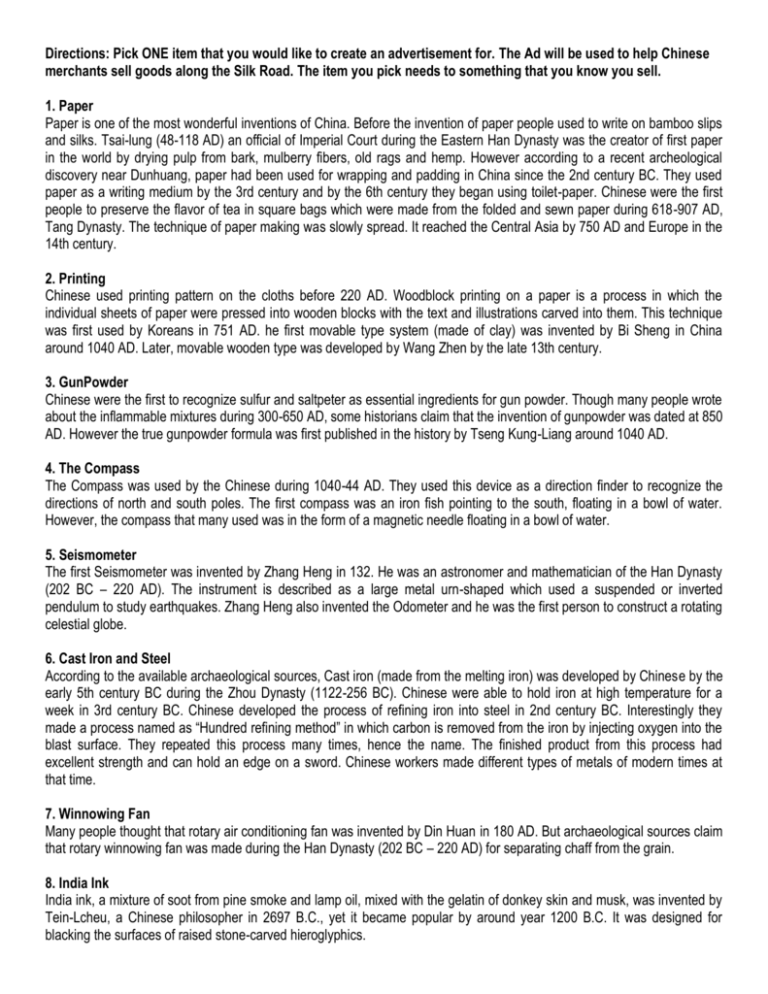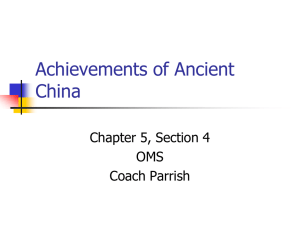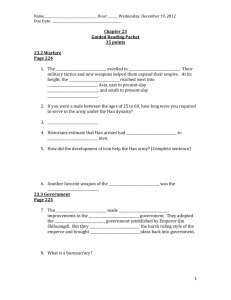Directions: Pick ONE item that you would like to create an
advertisement

Directions: Pick ONE item that you would like to create an advertisement for. The Ad will be used to help Chinese merchants sell goods along the Silk Road. The item you pick needs to something that you know you sell. 1. Paper Paper is one of the most wonderful inventions of China. Before the invention of paper people used to write on bamboo slips and silks. Tsai-lung (48-118 AD) an official of Imperial Court during the Eastern Han Dynasty was the creator of first paper in the world by drying pulp from bark, mulberry fibers, old rags and hemp. However according to a recent archeological discovery near Dunhuang, paper had been used for wrapping and padding in China since the 2nd century BC. They used paper as a writing medium by the 3rd century and by the 6th century they began using toilet-paper. Chinese were the first people to preserve the flavor of tea in square bags which were made from the folded and sewn paper during 618-907 AD, Tang Dynasty. The technique of paper making was slowly spread. It reached the Central Asia by 750 AD and Europe in the 14th century. 2. Printing Chinese used printing pattern on the cloths before 220 AD. Woodblock printing on a paper is a process in which the individual sheets of paper were pressed into wooden blocks with the text and illustrations carved into them. This technique was first used by Koreans in 751 AD. he first movable type system (made of clay) was invented by Bi Sheng in China around 1040 AD. Later, movable wooden type was developed by Wang Zhen by the late 13th century. 3. GunPowder Chinese were the first to recognize sulfur and saltpeter as essential ingredients for gun powder. Though many people wrote about the inflammable mixtures during 300-650 AD, some historians claim that the invention of gunpowder was dated at 850 AD. However the true gunpowder formula was first published in the history by Tseng Kung-Liang around 1040 AD. 4. The Compass The Compass was used by the Chinese during 1040-44 AD. They used this device as a direction finder to recognize the directions of north and south poles. The first compass was an iron fish pointing to the south, floating in a bowl of water. However, the compass that many used was in the form of a magnetic needle floating in a bowl of water. 5. Seismometer The first Seismometer was invented by Zhang Heng in 132. He was an astronomer and mathematician of the Han Dynasty (202 BC – 220 AD). The instrument is described as a large metal urn-shaped which used a suspended or inverted pendulum to study earthquakes. Zhang Heng also invented the Odometer and he was the first person to construct a rotating celestial globe. 6. Cast Iron and Steel According to the available archaeological sources, Cast iron (made from the melting iron) was developed by Chinese by the early 5th century BC during the Zhou Dynasty (1122-256 BC). Chinese were able to hold iron at high temperature for a week in 3rd century BC. Chinese developed the process of refining iron into steel in 2nd century BC. Interestingly they made a process named as “Hundred refining method” in which carbon is removed from the iron by injecting oxygen into the blast surface. They repeated this process many times, hence the name. The finished product from this process had excellent strength and can hold an edge on a sword. Chinese workers made different types of metals of modern times at that time. 7. Winnowing Fan Many people thought that rotary air conditioning fan was invented by Din Huan in 180 AD. But archaeological sources claim that rotary winnowing fan was made during the Han Dynasty (202 BC – 220 AD) for separating chaff from the grain. 8. India Ink India ink, a mixture of soot from pine smoke and lamp oil, mixed with the gelatin of donkey skin and musk, was invented by Tein-Lcheu, a Chinese philosopher in 2697 B.C., yet it became popular by around year 1200 B.C. It was designed for blacking the surfaces of raised stone-carved hieroglyphics. 9. Matches Chinese were the first people to invent the matches in the year 577 AD during the kingdom of Northern Ch’i. Early matches were made of sticks of pinewood with sulfur and the description was written by Ta’o Ku in the book “Records of the Unworldly and the Strange” in around 950 AD. However there is no evidence of using matches in Europe before 1350 AD. 10. Paper Currency Paper currency was first developed in China during the Tang Dynasty (618-907) according to the wishes of merchants who would like to avoid the bulk usage of copper coins in large commercial transactions. The Central Government adopted this system during the Song Dynasty (960-1279 AD. 11. Suspension Bridge The suspension bridge was invented by Chinese in as early as 1st century AD. Rope made from bamboo was first constructed in 300 AD on Min River. However there is documental evidence that an iron chain suspension bridge was built in Yunnan around 600 AD. 12. Umbrella Umbrella was invented in ancient China in around 2nd century BC. Available sources suggested that collapsible umbrellas were designed with mechanical sliding levers during Han Dynasty (202 BC – 220 AD). Wang Mang, an official of Han Dynasty had designed a collapsible umbrella for a ceremonial four-wheeled carriage. 13. Silk Silk was first developed in ancient China by 3000 BC. According to a legend, Leizu, Chinese Empress, wife of the Yellow Emperor of Chia, discovered silkworms spinning cocoons. She collected some cocoons and dropped a cocoon into the steaming water and amazed when a shining and soft thread started to separate itself from cocoon. Thus she invented silk loom in 28th century BC. Later Chinese used silk threads, silk belts and pieces of woven silk approximately in 2570 BC. 14. Chop Sticks and Forks King Zhou of Shang was the first person to make the chopsticks out of ivory in the 11th century BC. Chopsticks made out of bronze that belonged to 1200 BC were found in the archaeological sources. According to the available sources bone forks had been used in China during 2400-1900 BC. This suggests that fork had been used in China long before chop sticks. 15. Porcelain Though archaeological sources claim that porcelain was used in 3rd century AD, the true porcelain was made by Tao-Yue during 608 – 676 AD. He mixed white clay (found along the Yangzte River) to other types of clay which in result gave that white porcelain. Use this format to create your advertisement. It must be colorful and creative. Title: Chinese Invention Target Audience Picture of Invention Slogan (Who will want this item?) How is the invention used? How will this item be moved to buyers?








